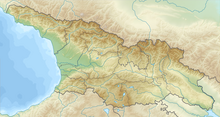| Veryovkina Cave | |
|---|---|
 155 m [508 ft] deep Babatunda pit at −400 m [1312 ft], the largest shaft in the cave | |
| Location | Abkhazia,[note 1] Georgia |
| Coordinates | 43°24′56″N 40°21′23″E / 43.41556°N 40.35639°E |
| Depth | 2,223 metres (7,293 ft) |
| Length | 17,500 metres (57,400 ft) |
| Discovery | 1968 |
| Geology | Limestone |
 | |
Veryovkina Cave (also spelled Verëvkina Cave, Abkhaz: Вериовкин иҳаԥы, Georgian: ვერიოვკინის მღვიმე, romanized: veriovk'inis mghvime) is a cave in Abkhazia, internationally recognized as part of Georgia. At 2,223 meters (7,257 ft) deep, it is the deepest-known cave on Earth.[1][2] Veryovkina is in the Arabika Massif, in the Gagra mountain range of the Western Caucasus, on the pass between the Krepost[3] and Zont[4] mountains, close to the slopes of Mount Krepost. Its entrance is 2,285 metres (7,497 ft) above sea level.[5] The entrance of the cave has a cross section of 3 m × 4 m (9.8 ft × 13.1 ft), and the depth of the entrance shaft is 32 metres (105 ft).[6]




